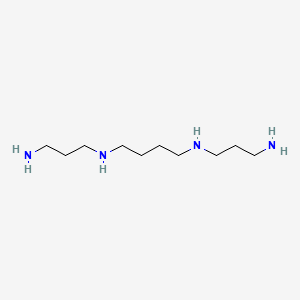



1. 71-44-3
2. Musculamine
3. Neuridine
4. Gerontine
5. Spermin
6. 4,9-diaza-1,12-dodecanediamine
7. N,n'-bis(3-aminopropyl)-1,4-butanediamine
8. Diaminopropyltetramethylenediamine
9. Spermine, Puriss
10. 1,4-butanediamine, N,n'-bis(3-aminopropyl)-
11. 4,9-diazadodecamethylenediamine
12. N,n'-bis(3-aminopropyl)butane-1,4-diamine
13. 1,4-bis(aminopropyl)butanediamine
14. Gerotine
15. 4,9-diazadodecane-1,12-diamine
16. 68956-56-9
17. Polyspermine
18. Nsc 268508
19. 1,4-bis(aminopropyl) Butanediamine
20. N1,n1'-(butane-1,4-diyl)bis(propane-1,3-diamine)
21. Spermine Free Base
22. Actilip Sp-91
23. 1,4-diaminobutane, N,n'-bis(3-aminopropyl)-
24. Brn 1750791
25. Ai3-26633
26. 1,5,10,14-tetraazatetradecane
27. 2fz7y3voqx
28. Nsc-268508
29. Nsc 268508; Neuridine
30. Chembl23194
31. Hydrocarbons, Terpene Processing By-products
32. 71052-31-8
33. Chebi:15746
34. N1,n4-bis(3-aminopropyl)-1,4-butanediamine
35. Nsc268508
36. 71-44-3 (free Base)
37. Spermidine 3hcl
38. 1,4-butanediamine, N1,n4-bis(3-aminopropyl)-
39. Spm
40. (3-aminopropyl)({4-[(3-aminopropyl)amino]butyl})amine
41. 1,4-butanediamine, N1,n4-bis(3-aminopropyl)-, Homopolymer
42. Spermina
43. Mls002472980
44. Diaminopropyl-tetramethylenediamine
45. Spermina [italian]
46. Smr001397086
47. Einecs 200-754-2
48. Unii-2fz7y3voqx
49. Mfcd00008215
50. Spermine Puriss
51. N,n'-bis(3-aminopropyl)-1,4-diaminobutane
52. Terpene Hydrocarbons, By Product
53. Einecs 273-309-3
54. 4,12-diamine
55. Spermine, >=97%
56. Tocris-0958
57. Gerotine [inci]
58. Spermine [mi]
59. Lopac-s-2876
60. Biomol-nt_000213
61. Bmse000117
62. Ec 273-309-3
63. Ncimech_000206
64. Spermine, Min. 98.0%
65. Lopac0_001077
66. Schembl14965
67. Wln: Z3m4m3z
68. Gtpl710
69. Spermine, Analytical Standard
70. 4-04-00-01301 (beilstein Handbook Reference)
71. Bpbio1_001086
72. Sperminetetrahydrochloride
73. Dtxsid9058781
74. Bdbm79403
75. Cid_5351186
76. 1, N,n'-bis(3-aminopropyl)-
77. Spermine, >=99.0% (gc)
78. Hy-b1777
79. Zinc1532734
80. Ccg-35276
81. Hsci1_000212
82. S3948
83. Akos024258603
84. Db00127
85. Sb38410
86. Sdccgsbi-0051047.p003
87. N1,n4-bis(3-aminopropyl)-butanediamine
88. Ncgc00015941-01
89. Ncgc00015941-02
90. Ncgc00015941-03
91. Ncgc00015941-04
92. Ncgc00015941-05
93. Ncgc00015941-10
94. Ncgc00024902-01
95. Ncgc00024902-02
96. Ncgc00024902-03
97. As-35114
98. Bp-21388
99. Nci60_035280
100. Db-055526
101. Cs-0013806
102. Ft-0625219
103. Ft-0631308
104. N,na?bis(3-aminopropyl)-1,4-diaminobutane
105. Spermine, Vetec(tm) Reagent Grade, >=97%
106. N,n''-bis(3-aminopropyl)butane-1,4-diamine
107. C00750
108. S-7400
109. Z-1049
110. 956s569
111. A866441
112. L001114
113. N1,n1'-(butane-1,4-diyl)dipropane-1,3-diamine
114. Q424597
115. N,n'-bis(3-aminopropyl)-1,4-tetramethylenediamine
116. N1,n1-(butane-1,4-diyl)bis(propane-1,3-diamine)
117. N1,n1'-(butane-1,4-diyl);bis(propane-1,3-diamine);
118. 2b445aed-6284-43e4-82fe-39598858d67f
119. 3-aminopropyl-[4-(3-aminopropylamino)butyl]amine;hydrochloride
120. N,n''''-bis(3-aminopropyl)butane-1,4-diamine;hydrochloride
121. N,n''''-bis(3-azanylpropyl)butane-1,4-diamine;hydrochloride
122. Spermine, Bioreagent, Amorphous Semi-solid, Suitable For Cell Culture
| Molecular Weight | 202.34 g/mol |
|---|---|
| Molecular Formula | C10H26N4 |
| XLogP3 | -1.1 |
| Hydrogen Bond Donor Count | 4 |
| Hydrogen Bond Acceptor Count | 4 |
| Rotatable Bond Count | 11 |
| Exact Mass | 202.21574685 g/mol |
| Monoisotopic Mass | 202.21574685 g/mol |
| Topological Polar Surface Area | 76.1 Ų |
| Heavy Atom Count | 14 |
| Formal Charge | 0 |
| Complexity | 86.1 |
| Isotope Atom Count | 0 |
| Defined Atom Stereocenter Count | 0 |
| Undefined Atom Stereocenter Count | 0 |
| Defined Bond Stereocenter Count | 0 |
| Undefined Bond Stereocenter Count | 0 |
| Covalently Bonded Unit Count | 1 |
For nutritional supplementation, also for treating dietary shortage or imbalance
Spermine is a polyamine. It is an organic molecule that is involved in cellular metabolism.
Spermine is derived from spermidine by spermine synthase. Spermine is a polyamine, a small organic cations that is absolutely required for eukaryotic cell growth. Spermine, is normally found in millimolar concentrations in the nucleus. Spermine functions directly as a free radical scavenger, and forms a variety of adducts that prevent oxidative damage to DNA. Oxidative damage to DNA by reactive oxygen species is a continual problem that cells must guard against to survive. Hence, spermine is a major natural intracellular compound capable of protecting DNA from free radical attack. Spermine is also implicated in the regulation of gene expression, the stabilization of chromatin, and the prevention of endonuclease-mediated DNA fragmentation.